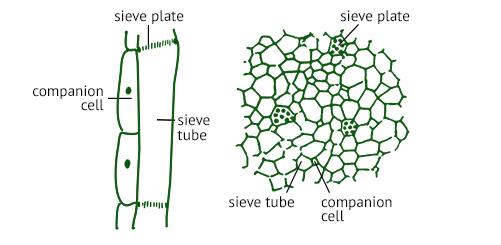The phloem is the vascular tissue that carries out the function of translocation (i.e the process of transporting photosynthate materials from the photosynthetic plant organs to various parts of the plant. Phloem is made up of the following major components:
- Sieve element
- Companion cell
- Phloem parenchyma
- Phloem schlerenchyma
In angiosperms, the sieve element is referred to as sieve tube (element) and the cell associated with it is referred to as a companion cell. In gymnosperms and other primitive vascular plants, the sieve element is a sieve cell whereas the associated cell is referred to as an albuminous cell.
The companion cells are specialized parenchyma cells in phloem tissues of the angiosperms. They are nucleated living cells with several ribosomes, plastids and mitochondria. On the other hand, a sieve tube is a tube made up of sieve-tube elements joined end-to-end. In other words it is a series of cells forming a tube through which the photosynthate material flows through.
Companion cells are closely associated with the sieve tube elements, though the companion cell is smaller and narrower than the sieve tube element. They are connected through the plasmodesmata. Companion cells also provide energy to sieve elements during food translocation.

In this article, get to understand the underlying difference and similarities between sieve tube elements and companion cells in details. The basis of comparison includes: function, presence, metabolic activity and transverse wall among others.
What You Need To Know About Sieve Tubes (Characteristics)
- Sieve Tubes are a series of cells placed end to end to form a continuous tube.
- The sieve tubes are usually living cells with an elongated structure.
- Sieve tubes contain fewer mitochondria.
- Sieve tubes are responsible for the transport of food throughout the plant body.
- In sieve tubes, nucleus may be prominent in young stage of the plant but later disappears.
- The sieve cells of gymnosperms and pteridophytes have no companion cells.
- The connecting strands in a sieve area remains encased in a cylinder of substance referred to as callose.
- Sieve tubes show low rate of metabolic activity.
- The transverse wall of sieve tubes contains pores.
- Sieve tubes are comparatively large cells with fairly large vacuoles.
What You Need To Know About Companion Cells
- Companion cells are specialized parenchyma cell, located in the phloem of flowering plants and closely associated in development and function with sieve tube elements.
- The companion cells are living and elongated in structure with thin walls.
- Companion cells contain a large number of mitochondria and ribosomes as they are very metabolically active.
- Companion cells are responsible for regulating the activity of the sieve element.
- Companion cells have a prominent elongated nucleus, which is retained throughout the life of the cell.
- The companion cells only exist in angiosperms.
- Structures like callose, are not found in companion cells.
- Companion cells show high rate of metabolic activity.
- The transverse wall of companion cells does not contain pores.
- There are vacuoles in the companion cells but they remain very small and also contain nucleus.
Sieve Tubes Vs Companion Cells In Tabular Form
| BASIS OF COMPARISON | SIEVE TUBES | COMPANION CELLS |
| Description | Sieve Tubes are a series of cells placed end to end to form a continuous tube. | Companion cells are specialized parenchyma cell, located in the phloem of flowering plants and closely associated in development and function with sieve tube elements. |
| Nature Of Cells | They are usually living cells with an elongated structure. | They are living and elongated in structure with thin walls. |
| Mitochondria & Other Organelles | They contain fewer mitochondria. | They contain a large number of mitochondria and ribosomes as they are very metabolically active. |
| Function | They are responsible for the transport of food throughout the plant body. | They are responsible for regulating the activity of the sieve element. |
| Prominence Of Nucleus | In sieve tubes, nucleus may be prominent in young stage of the plant but later disappears. | Companion cells have a prominent elongated nucleus, which is retained throughout the life of the cell. |
| Presence | The sieve cells of gymnosperms and pteridophytes have no companion cells. | The companion cells only exist in angiosperms. |
| Other Structures | The connecting strands in a sieve area remains encased in a cylinder of substance referred to as callose. | Structures like callose, are not found in companion cells. |
| Metabolic Activity | They show low rate of metabolic activity. | They show high rate of metabolic activity. |
| Transverse Wall | The transverse wall of sieve tubes contains pores. | The transverse wall of companion cells does not contain pores. |
| Size Of Vacuole | Sieve tubes are comparatively large cells with fairly large vacuoles. | There are vacuoles in the companion cells but they remain very small and also contain nucleus. |
What Are The Similarities Between Sieve Tubes And Companion Cells?
- Both companion cells and sieve tube are living cells with an elongated shape.
- Sieve tube and companion cells are both connected through plasmodesmata.
- Companion cell and sieve tube, both transport food throughout the plant.
- They both are part of sieve element-companion cell complex.
- They are both found in the phloem tissue of angiosperms.
- They both originate from the meristem. The epigenetic factors drive their differentiation.
- Both contain mitochondria, Endoplasmic reticulum and a cell wall made up of cellulose.
You May Also Read:
Comments are closed.